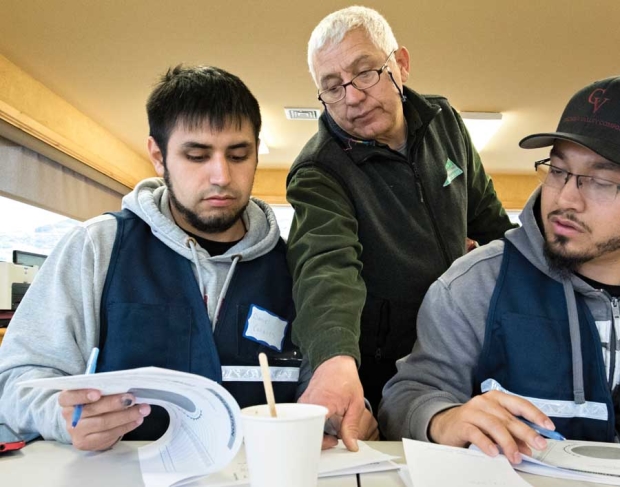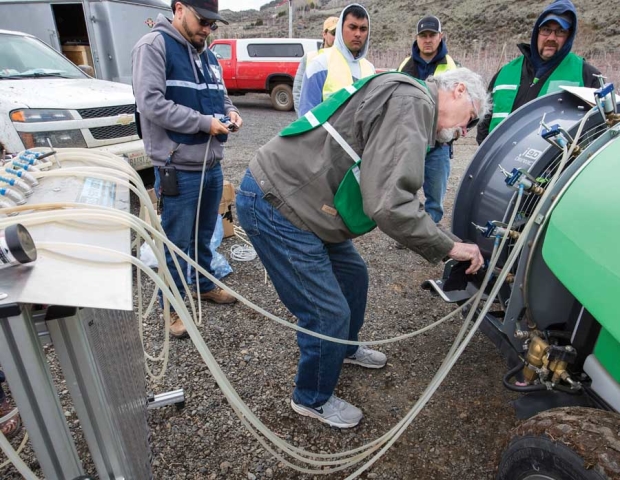The federal government announced revisions to the federal Agricultural Farmworker Protection Standard last fall, marking the first major updates to the program since it was implemented more than 20 years ago.
The decision has many states reviewing their own programs to ensure they meet the proposed regulations, which include mandatory annual training for farm workers and pesticide handlers — rather than training once every five years — and additional content areas that must be covered in those training sessions, among other things.
The protection standard is a program managed by the Environmental Protection Agency.
In Washington, many of the requirements in EPA’s proposal, though not all, are already being met, thanks in large part to a progressive farm worker education program that has provided training to more than 20,000 people since its inception in 2000 and has served as a model to other states.

Ofelio Borges of the Washington State Department of Agriculture talks during a spray application training in Naches, Washington, in March. The session is one of several training workshops and hands-on sessions presented in cooperation of state agencies, Washington State University and agriculture groups. Flor Servin, at right in red jacket, of the Washington State Department of Labor & Industries, is also a member of the training team. (TJ Mullinax/Good Fruit Grower)
Washington created its farmworker education program — a partnership of the Washington State Department of Agriculture, the Washington Department of Labor and Industries, Washington State University and industry sponsors, including the Washington State Tree Fruit Association — after field research showed that both agricultural employers and employees lacked awareness of personal protective equipment requirements.
The goal: train farm workers, supervisors and operators, including the highly vulnerable group of Spanish-speaking workers, to work safely around pesticides and pesticide residues.
“We know our program is pretty unique,” said Ofelio Borges, supervisor of the Washington State Department of Agriculture’s farm worker education program. “We have worked with other states that want to mimic what we’re doing.”
Today, the program offers several hands-on workshops for farm workers and supervisors that cover pesticide safety, respirator protection and fit-test procedures, as well as a “train the trainer” class.
A pre-license pesticide applicator training is delivered to employees of all types of agricultural industries, including tree fruit and wine and table grapes.
Washington also was one of the first states to provide both the study manual and exam in Spanish.

Jaime Ramon checks Daniel Canales’ math during an exercise to accurately calculate spray nozzle application amounts. (TJ Mullinax/Good Fruit Grower)
The newest course, tested in a pilot program last year and now added as part of the program in 2016, provides information needed for workers to perform air blast spraying and boom sprayer calibration.
The course stemmed from an increase in the number of incidents of spray drift, which after declining for several years spiked to 72 complaints alleging drift in 2013, highlighting the need for additional education and farm worker familiarity with spray equipment.
The course also addresses many other safety issues, including tractor and sprayer safety.
Sprayer training
Watch the Spanish version here, “Majores práctica para manejar equipo de aplicación.”
Orchards have changed significantly in recent years.
Sprayers that were designed for orchards comprised of big, stand-alone trees now face fruiting walls, but the sprayer technology has changed little, said Borges, who has been with the education program for 14 years after working for several fruit companies as an orchard manager.
In addition, the traditional way to calibrate a sprayer is very complicated, and a lot of workers simply don’t know how to do it. The class teaches step by step what calibration is and how to do it.
“An applicator’s perspective is very limited, so if they’re drifting, they’re going to be the last ones to know,” Borges said. “We advise workers to run sprayers through with water and get to know where their product is going.”
The class also focuses on weather-tracking technologies that can be used to reduce drift.
“We’re talking to these workers about safety and weather and about how these new technologies can be used to reduce drift,” Borges said. “We want to teach them how to use the equipment, but most of all, we want to teach them to be safe.”
Klipsun Vineyards, located in Washington’s Red Mountain appellation near Benton City, sent three workers to a recent sprayer class sponsored by G.S. Long Co. One of them, Roy Garcia, supervises about 24 farm workers during harvest and said he will be teaching what he learns at the vineyard’s safety meeting each month.
Many programs offer video demonstrations to teach workers how to perform a task, but the Washington workshops require attendees to learn and apply the information in the orchard, ensuring they are more likely to walk away with the knowledge, he said.

Wayne Worby, attaches a large spray application measuring device during spray application training in Naches, Wash. (TJ Mullinax/Good Fruit Grower)
Wayne Worby, who grows 17 acres of cherries near Selah, Washington, said the competitive industry demands that growers stay up to date on technologies, including spray technology. “Twenty years ago, we were harvesting 50 bins to the acre and were pretty happy with that. Now, it’s 150,” he said.
An added benefit of the class is that the instructors aren’t the only teachers; plenty of attendees offer ideas as well, he said. Worby, who has been growing fruit since 1979, uses an aging, power blast sprayer that requires him to think differently about how to calibrate and apply pesticides.
“We’re always trying to outthink a plant, and the plant always wins,” he said. “But other people have resources too, so I like to hear what others are doing to validate what I’m doing or get new ideas.”
Progressive change
Jaime Ramon, a WSDA employee who has worked in training and compliance for 10 years, said that when he started with the department, farm worker training consisted of about three or four classes over the course of the winter, “and one or two might be canceled.” The program started during the last week of January and ran through the first week of April.
Today, the number of classes has grown to 22, beginning each November.
“We give them the tools. We give them the ideas, the best management practices for pesticide application,” he said. “But we learn a lot from the trainees. They are doing the job. The response has been really good, but the more participation, the more we learn to make changes to do this better, too.”
Pre- and post-training surveys show that 70 percent of people attending the pesticide handler training are there for the first time, while 30 percent are returning for a refresher, said Flor Servin of Labor and Industries.
For the train the trainer class, many more people repeat it to ensure they are up to date on the latest information.
“It’s an excellent source of information,” Servin said. “I don’t think there’s any organization, or at least I’m not aware of any other organization, providing these services and information with the quality that we do, with the detail and with the methodology that we use. We are always changing and improving the programs, every year. I see that as a tremendous benefit, not just to workers but also to managers, growers and the industry.”
In December, the Washington State Tree Fruit Association recognized the farm worker education team — WSDA’s Borges and Ramon and L&I’s Servin and Ramon Benavides — with the Latino Leadership Award.
In introducing the award winners, WSU Extension specialist Karen Lewis noted that the team’s hands-on training on everything from worker protection standards to respirator use has improved safety, both at work and at home, for thousands of people.
“They’re not just numbers,” she said. “These are people changing lives.” •
– by Shannon Dininny
ONLINE
For more information on Washington’s Farmworker Education Program, visit 1.usa.gov/236i9z2
New federal regulations for pesticide use
Most of the changes to the federal Agricultural Farmworker Protection Standard take effect Jan. 1, 2017.
Among other things, the new standard eliminates a five-day grace period allowing workers to labor in an area where pesticides have been used before they receive training.
(This rule had already been implemented in Washington.) The standard also mandates annual training for field workers and pesticide handlers, rather than training once every five years.
Effective Jan. 1, 2018, training courses for pesticide handlers must cover 36 points, up from 13 points. The number of training points for field workers increased from 11 to 23 points.
In addition, the pesticide safety poster used by agricultural employers will be modified by EPA for use effective Jan. 1, 2018.
For more information about EPA’s revised Agricultural Worker Protection Standard go to 1.usa.gov/1UEdX4M.






Spraying application updates are nice but what about EPA making a regulatory system that provides public knowledge of what the communities are breathing in. Air doesnt have borders and many besides the people who wear protection gear know what they are encountering.